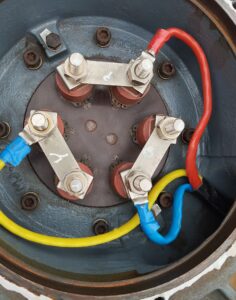Why Testing Motor Insulation Resistance (IR) is Vital
Introduction
Testing for insulation resistance (IR) for induction motors is a key maintenance step that is essential for determining the efficiency and dependability of electric motor systems. This vital stage in motor maintenance acts as a preventative approach to spot and address problems with moisture, temperature changes, and mechanical stress—all of which can eventually cause the insulation to slowly deteriorate. We’ll go into more detail about the importance of IR testing for guaranteeing the dependability and safety of motors in this article.
Detecting Underlying Issues in Induction Motors
Electric motor efficiency and longevity can be jeopardized by silent enemies such as moisture, temperature changes, and mechanical stress. The insulation that protects the motor’s interior components is slowly destroyed by these forces. Regular IR testing gives you crucial information about the insulation’s condition. is a diminishing insulating resistance value, which enables you to treat them before they develop into severe motor failures and Operation downtime.
Motor Dependability
Electric motors are the workhorses of numerous industries, powering a wide range of machinery and equipment. The reliability of these motors is essential to maintain uninterrupted operations. IR testing contributes to this reliability by helping you identify potential weaknesses in the insulation system. This proactive approach allows for timely maintenance, preventing unexpected breakdowns and costly downtime.
Enhancing Safety in Induction Motors
Safety is a paramount concern in any industrial setting. Motors operating with compromised insulation pose a significant safety risk, as they can lead to electrical shorts, fires, or even personnel hazards. IR testing serves as a safety net by pinpointing insulation problems before they can result in dangerous situations. By promptly addressing these issues, you ensure a safer work environment for your employees and protect valuable assets.
Compliance and Longevity
Many industries have stringent regulatory requirements regarding electrical equipment maintenance. IR testing not only helps you meet these compliance standards but also extends the lifespan of your motors. Properly maintained motors tend to have a longer operational life, reducing the need for frequent replacements and the associated costs.
How to carry out an Ohmic/Insulation resistance test on induction motors

- Disconnect Power: Always disconnect the motor from the power source and lock/tag out the electrical supply to prevent accidental start-up.
- Grounding: Ensure that the motor is properly grounded to prevent electrical shock hazards.
- Personal Protective Equipment (PPE): Wear appropriate PPE, such as gloves and safety glasses, to protect yourself during the testing process.
Equipment Needed: You will need the following equipment:
- Digital Multimeter (DMM) or Ohmmeter: To measure resistance.
- Motor Wiring Diagram: To identify the winding terminals.
- Disconnect Motor Leads:
- Typically, there will be three terminals for a three-phase motor: U, V, and W.
- Disconnect Motor Leads:
- Disconnect the motor leads from the motor controller or starter.
- Make sure the motor is isolated from any electrical power source
- Setup your multimeter and measure the resistance:
- Turn on the digital multimeter (DMM) and set it to the resistance (ohms) measurement function.
- Connect the DMM leads to the motor winding terminals.
- For a three-phase motor, you will measure the resistance between each pair of terminals (U to V, V to W, and W to U).
- Record the resistance values.
- Compare the measured resistance values to the motor’s specifications or manufacturer’s data to determine if the windings are within the acceptable range.
- Typically, the resistance values should be roughly equal for all three windings, and they should match the motor’s specifications.
- Abnormally high or low resistance readings may indicate problems such as short or open windings.
- If the resistance values are significantly different from each other or outside the specified range, further investigation or motor repair may be necessary.
see also: Winding Resistance check

Hello Neat post Theres an issue together with your site in internet explorer would check this IE still is the marketplace chief and a large element of other folks will leave out your magnificent writing due to this problem.
Thank you
Would check it out
[…] CHECKOUT: Testing of Motor insulation resistance & […]